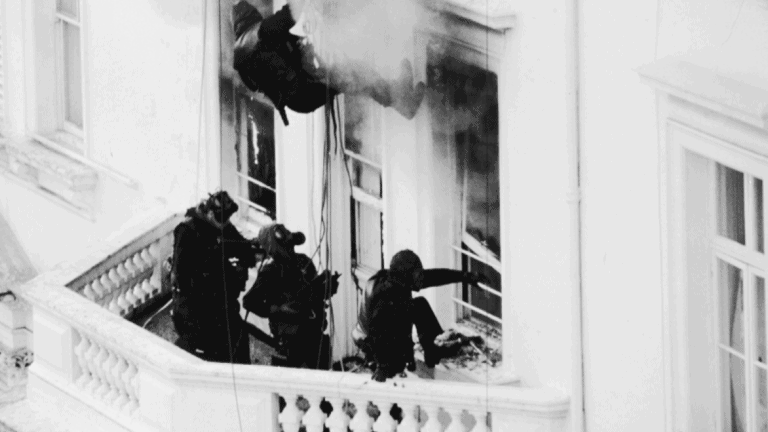
1. Codename: Operation Nimrod
Operation Nimrod, known colloquially as the Iranian Embassy Siege occurred on April 30th, 1980. Six armed revolutionaries of the Democratic Revolutionary Movement for the Liberation of Arabistan (DRMLA) seized the Iranian Embassy at No.16 Princes Gate, London, taking twenty-four hostages. Six days later, the Special Projects (SP) Team of the 22 Special Air Service Regiment (SAS) Counter Revolutionary Warfare Wing (CRW), stormed the building and killed five of six assailants. Overall, Operation Nimrod was (almost) a qualified success. The SAS emerged from almost total obscurity to become a household name in the UK. Some 43 years later, the SAS still receive recognition as the world’s leading counter-terrorism unit.
Fig.1 SAS veteran Corporal Robin Horsfall on Operation Nimrod: the preparation, planning, and storming of the Iranian Embassy in 1980. Interviewed in 2017.
2. Origins of Operation Nimrod
The assailants belonged to the DRMLA which sought independence for an oil-rich region in south-western Iran known officially as Khuzestan. Known locally as ‘Arabistan’, the region’s inhabitants are ethnic Arabs with a long-standing history of revolt against Iran due to ethnic differences. As a major oil-producing region, Khuzestan is the source of Iran’s wealth – having been developed by British and American companies prior to and during the Shah’s reign, which ended with the onset of Islamic revolution in early 1979. Reports from this period indicate that Iran was exporting some five million barrels of Khuzestani oil per day. Nearly one-tenth of the world’s oil production [source].
2.1 Mass Oil Workers’ Strikes
Khuzestanis did not reconcile with the idea of Persian overlordship. In the advent of WWII, Khuzestanis rebelled in a bid to link themselves with Iraq but with somewhat limited success. Consequently, Khuzestani dissent remained largely dormant until 1978 when mass oil workers’ strikes halted the flow of oil to Tehran. These oil strikes played such an instrumental role in paralysing and fracturing the state. Such that it fomented insurrection and enabled the Shah’s downfall [source].
However, despite the establishment of Ayatollah Khomeini’s regime, any Khuzestani hopes of self-rule quickly dissipated. Khomeini did not wish to see the new Islamic state partitioned into ethnically homogeneous regions. With Persians still a dominant majority, but separated from Kurds in the West, Abzerbaijanis in the North-West, Baluchis in the South-east, and Khuzestanis in the South-west. As a result, the Khuzestanis began a campaign of political agitation and violence. They inflicted widespread damage to the oil industry of Iran and considerably reducing exports – an 80 per cent decline [source].
2.2 Who Were the Democratic Revolutionary Movement for the Liberation of Arabistan (DRMLA)
To challenge Iran’s regional hegemony, Saudi supported hostile Sunni regimes that surrounded Iran, chiefly Saddam Hussein’s regime. The latter fought Iran from 1980 to 1988 to excise Tehran from Arab Shi’ites in Iraq and the Levant.
With growing animosity between Iran and Iraq, both sides began to call for the other’s overthrow and supported agents pursuing a policy of sabotage and assassination. For instance, Iranians backed an ‘Islamic Liberation Army’ consisting of Shi’as from southern Iraq. By contrast, Saddam Hussein supported calls for Khuzestani autonomy. He did so by sending armed men into the region to finance, train, and equip its dissidents, and blow-up police stations, bridges, and oil installations – all in a bid to erode Khomeini’s authority [source].
The DRMLA was originally a splinter group of the Popular Front for the Liberation of Arabistan [Khuzestan]. It was an Iraqi-backed group seeking the independence for Khuzestan, a largely Arab-populated province in southwestern Iran.
2.3 Preamble to Operation Nimrod: Why Attack the Embassy in London?
The seizure of the Embassy offered Khuzestani dissidents a high-profile method of attacking Iran in a community largely sympathetic to the Arab cause. Not to mention, an international press corps eager to televise events for the court of world public opinion. The DRMLA’s grievances were largely unknown to the Western public. Of particular significance, the Khuzestani siege of the Iranian Embassy in London was a logical parallel, an echo of the Iranian takeover of the US Embassy in Tehran that had occurred a year prior [See: Operation Eagle Claw].
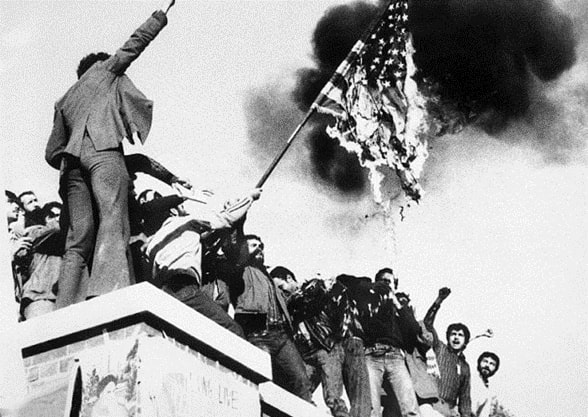 Fig.2 Iranian students seize the US Embassy in Tehran 1979
Fig.2 Iranian students seize the US Embassy in Tehran 1979
3. The Seizure of the Embassy
3.1 Day One: April 30, 1980. Princes Gate: The Iranian Embassy
With no police presence outside the Embassy to detect their ascent and heavily armed, six DRMLA associates began the operation. They opened fire and overpowered PC Trevor Lock, from the Diplomatic Protection Group (DPG). Unbeknownst to the assailants, Lock succeeded in transmitting an emergency signal to Scotland Yard.
In their holdalls, the Khuzestani assailants carried:
- Two 9mm SMG machine pistols
- Three Browning automatic handguns with 13-round magazines loaded with Winchester hollow-point ammunition
- A Polish-made Skorpion sub-machine gun
- A .38 revolver
- Several Russian hand grenades
With the Embassy effectively under the group’s control, the group’s leader, known as Oan (Oan Ali Mohammed, police codename: ‘Salim’) introduced himself and his assailants as ‘members of the Democratic Revolutionary Front for the Liberation of Arabistan’, referring to their alternative name, ‘the Group of the Martyr’. He then issued the following demands. Such demands, if not met by noon Thursday 1 May, Oan would order for the execution of the embassy’s occupants.
- The group’s human and legitimate rights
- Autonomy for Arabistan
- The release of ninety-one Arabs held in Iranian jails
- The group’s safe passage out of Iran to the destination of their choice (Presumably Iraq)
3.1.1 Hostages
| Dr Gholam-Ali Afrouz [Chargé D’Affairs] | Shirazed Bouroumand [Embassy Secretary] | Chris Cramer [BBC TV News Producer] | Ahmed Dadgar [Medical Clerk] |
| Dr Abdul Fazi Ezzati [Iranian Cultural Attaché] | Abbas Fallahi [Embassy Doorman] | Muhammed Hashir Farqui [Editor of the Muslim political magazine Impact International] | Ali Guil Ghanzafar [Pakistani tourist] |
| Sim Harris [BBC sound recordist] | Nooshin Hashemenian [Embassy Secretary] | Roya Kaghachi [Embassy Secretary] | Hiyecg Sanei Kanji [Embassy Secretary] |
| Mustapha Karkouti [Syrian Journalist for Lebanese paper Assafir] | Vahid Khabaz [London correspondent for Tehran-based newspaper Keyhan]. | Abbas Lavasani [Embassy Chief Press Officer] | Police Constable Trevor Lock [Diplomatic Protection Group, Metropolitan Police]. |
| Moutaba Mehrnavard [Carpet dealer]. | Aboutaleb Jishverdi-Moghaddam [Iranian Attaché] | Muhammed Moheb [Embassy accountant]. | Ron Morris [Embassy Manager and Chauffeur] |
| Frieda Mozafarian [Press Officer] | Issa Naghizadeh [First Secretary] | Ali Akbar Samadzadeh [Embassy staff] | Ali Aghar Tabatabai [Banker from Central Bank of Iran] |
| Kaujouri Muhammad Taghi [Accountant] | Zahra Zommorrodian [Embassy Clerk] |
Names of those taken hostage at the Iranian Embassy
3.1.2 Assailants
| Salim Towfigh – alias Oan Ali Mohammed – known during the siege as Salim or Oan | Faisal Jassem – alias Shakir Abdullah Radhil – know during the siege as Hassan |
| Makki – alias Makki Hanoun Ali – known during the siege as Makki | Abbas – alias Themir Mohammed Hussein – known as Abbas or ‘Ugly’ by hostages |
| Fowzi Badavi Nejad – alias Ali Ahmed Jassim – known during the siege as Ali |
Names of the assailants who seized the Iranian Embassy
3.1.3 First on the Scene
Thus alerted, the Metropolitan Police responded with John Dellow, Deputy Assistant Commissioner, assuming immediate control. He established Alpha Control – the main police incident headquarters – with the dispatch of its C13 Anti-Terrorist Squad. Coupled with electronic intelligence specialists from C7 (Scotland Yard’s Technical Support Branch) who could deploy surveillance equipment with which to monitor sound and movement inside the building.
These units joined the Special Control Group and D11 police marksmen, known as ‘Blue Berets’. They took up positions around the embassy. Contingency had also to be made for the possibility of SAS intervention. Since the circumstances might require resources beyond the capabilities of the police alone. Using a green telephone passed through a window on the ground floor of the embassy, the police soon established contact with Oan through their team of negotiators.
 Fig.3 Faisal, Oan’s second-in-command. He is collecting a message from a shoebox attached to a long pole held by a plain-clothed policeman at the extreme left of the Iranian Embassy
Fig.3 Faisal, Oan’s second-in-command. He is collecting a message from a shoebox attached to a long pole held by a plain-clothed policeman at the extreme left of the Iranian Embassy
3.1.4 Contacting the ‘Kremlin’
The incident not only implicated the police. The Army, specifically the SAS, became aware from the outset. By coincidence, the SAS knew of the incident even before they received official notification. At 1144hrs, an ex-D Squadron SAS corporal named Dusty Gray, then serving in the Metropolitan Police as a dog-handler, contacted the ‘Kremlin’ (the nickname for the SAS headquarters at Hereford) to provide Lieutenant-Colonel Mike Rose, Commanding Officer of the 22 SAS with intel.
Rose did not wait for instruction from Whitehall, readying his squadron, and later establishing preliminary reconnaissance with Dellow in London. Thus, six hours before the Ministry of Defence issued formal orders for the Special Projects Team, dressed in civilian clothes, to proceed West London, had already left.
3.1.5 Ruling with an Iron Fist
Under the direction of UK PM Margaret Thatcher, the government decided that patient negotiation should be first recourse. Although if any hostages were wounded, a military assault would then be considered. In the event of a hostage death, the SAS would proceed. Thatcher recognised that there would need to be a degree of flexibility. Yet she ruled out the possibility of allowing the assailants to leave the country as free agents [source], [source]. However, it did present a diplomatic challenge. Forty-nine American hostages were being held in Tehran. Earlier that same month, President Carter had ordered an abortive helicopter borne raid in an attempt to free them.
In response, the UK Cabinet had considered US requests of imposing economic sanctions on Iran. In view of their refusal to release US hostages. It was thus not surprising that the diplomatic response from Iran vis-à-vis the Iranian Embassy siege was cold. The then-Iranian foreign minister made it clear that Iran would meet none of the terrorists’ demands. He also declared that if any hostages died, an equal number of Iranian Arabs would be ‘tried and executed’ [source].
“My policy would be to do everything possible to resolve the crisis peacefully, without unnecessarily risking the lives of the hostages, but above all to ensure that terrorism should be – and be seen to be – defeated.”
– UK PM Margaret Thatcher [source].
3.1.6 Thatcher’s Non-Negotiables
Thatcher established three principles from the outset:
- The application of UK law. Notwithstanding the fact the incident was taking place in a foreign embassy.
- The terrorists were under no circumstances allowed to leave the country.
- A peaceful resolution was paramount. To which end, the police were to negotiate for as long as necessary to achieve this.
[Source].
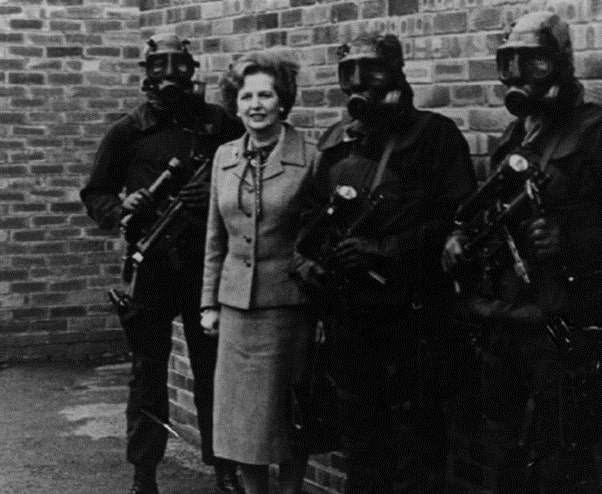 Fig.4 Margaret Thatcher photographed with Operation Nimrod’s SP Team
Fig.4 Margaret Thatcher photographed with Operation Nimrod’s SP Team
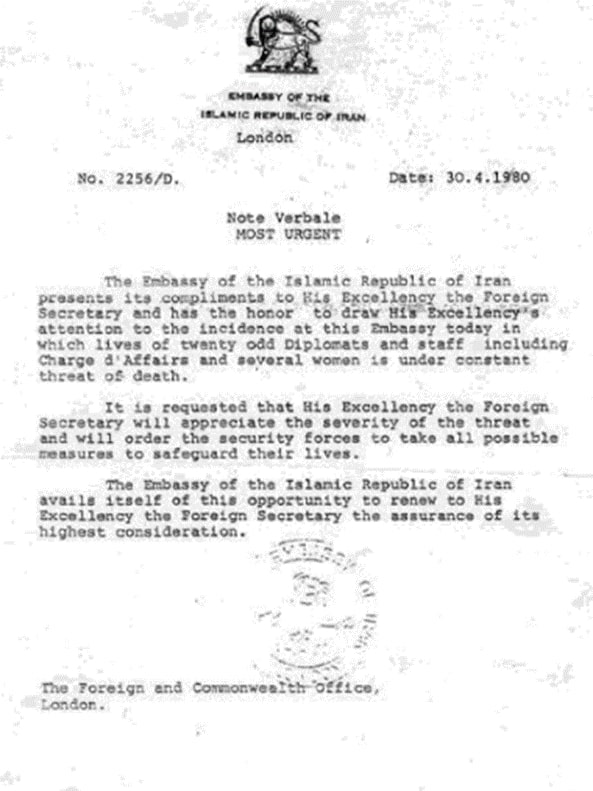 Fig.5 Urgent Telex from Iran Embassy to FCO, London 1980
Fig.5 Urgent Telex from Iran Embassy to FCO, London 1980
3.2 Day Two: May 1, 1980
In the early hours of 1 May, Blue and Red SAS teams arrived at the Regent’s Park Barracks. By the afternoon, Lieutenant-Colonel Rose discovered a concealed route into the Embassy. Located across the communal basement passage which ran the length of the terrace, allowing the SAS to enter undetected.
At 0330 hrs, 24 men of the Red Team entered no.14 terrace unobserved. By which time, Rose had an ‘immediate action plan’ should the circumstances require imminent SAS intervention. E.g., if the terrorists began killing hostages.
However, Rose recognised that this could be no more sophisticated than entering through the Embassy’s top-floor windows, using sub-machine guns and CS gas with the objective of rescuing as many hostages as possible. It was thus difficult to ascertain the location of the terrorists within the Embassy. In addition, any other course of action relied heavily on intelligence. To this end, Rose drafted a ‘deliberate assault plan’ while the Red Team remained on alert.
3.2.1 The Importance of Intelligence Gathering
If the SAS were going to storm the Embassy, with minimal collateral damage to the hostages, then success lay in gathering accurate intelligence and rehearsing the attack based on said intelligence. In so doing, Army and SAS intelligence officers gathered intelligence on the building’s blueprints. They also consulted people who had recently visited the building to learn of any recent alterations and the positioning of large obstacles -such as furniture- to provide a rough skeleton outline.
By happy circumstance, some years prior, the Shah government had asked the SAS to survey the Embassy’s building. They assessed its security and made recommendations for its improvement. However, there was no indication of which, if any, recommendations had been adopted or other changes since the inception. Upon SAS recommendations, it was advised that the Embassy have armoured glass fitted to the ground and first-floor windows. Whether such work had been carried out was unknown.

3.2.1 Terrorists Release Chris Cramer
Armed with a rough blueprint, police carpenters built a scale model of the Embassy. Aided by the Pioneer Company of the Irish Guards who also constructed a life-sized replica of the Embassy.
At 1115 hrs, Oan released one of the sick hostages, a woman named Frieda Mozafarian. He refused, however, to release Chris Cramer, the BBC sound organiser, who had also become violently ill. For their part, the police refused to reciprocate by allowing a doctor to access the embassy.
However, the authorities had yet to cut international telephone communication, and thus Oan contacted the Iranian Foreign Ministry in Tehran. He subsequently learned from the then-Foreign Minister, Sadegh Ghotzbadeh, that the terrorists were regarded as agents of the Carter Administration and CIA and the hostages would ‘doubtless be willing to sacrifice their lives as martyrs for the Islamic Revolution’ [source].
Faced with an ailing Cramer, Oan released him through the front door of the Embassy. A tactical oversight error on part of Oan, as the police immediately debriefed Cramer, enquiring into the number of gunmen, their weapons, the layout of the embassy, and the location of hostages.
3.2.2 The Enemy Next Door
However, the police sought real-time intelligence. They therefore sought permission for special access into no.17, the Ethiopian Embassy next door. Once inside, the MI5 began installing microphones into the walls and lowering listening devices down the chimneys from the roof, for the purpose of identifying the positions of the terrorists and hostages. The Embassy consisted of five storeys above ground, plus a basement, the whole structure containing more than 50 rooms. The solid Victorian construction also meant shared terraced walls of granite measuring 55.9 cm on one side and 48.3 cm on the other. Needing a distraction to cover the sound of their work, the UK government requested a road drilling on a fictitious gas main near the embassy.
However, not wishing to unnerve the terrorists, Rose instead re-routed incoming aircraft bound for Heathrow to descend low over the southern boundary of Hyde Park. It allowed engineers to remove bricks separating the Iranian and Ethiopian embassies, leaving a veneer of plaster for an assault team to enter through.
3.2.2 Terrorists issue their demands to the BBC’s Tony Crabb
By 1500 hrs, having already allowed the 12pm deadline, as well as a second one of 1400 hours, to pass without incident, Oan changed his demands. He requested three ambassadors from Arab countries to serve as mediators to negotiate for a plane to take him and his accomplices out of Britain.
However, Thatcher rejected the notion of a foreign intermediary. In her memoirs, she explains that the involvement of foreign intermediaries would risk conflating and derailing their objectives. Not least the Jordanians, whom the UK government was prepared to trust, refused any involvement [source].
3.3 Day Three: May 2, 1980
By 0930hrs, Oan threatened to kill a hostage in retaliation for police having cut off his access to telephone and telex communication to deprive terrorists of outside information.
Refusing to bend to Oan’s demands, the police refused, provoking Oan to request a BBC representative. At 1500hrs, the police brought in Tony Crabb, the managing editor of BBC TV news. Crabb had personal connections to Sim Harris, a hostage at the Iranian Embassy.
Harris shouted Oan’s demands from the first-floor window. This included:
- A coach to convey the gunmen, hostages and one Arab ambassador to Heathrow.
- Release of non-Iranian hostages at Heathrow.
- An aircraft to take the remaining hostages, gunmen, an ambassador to an unspecified country in the Middle East. After which, all the remaining hostages would be released.
- Televised terrorist demands by the BBC that same evening.
Later establishing contact with the Embassy caretaker, who was on holiday, the police received intimate knowledge of the embassy layout. From this, the police and SAS were able to learn layout of major rooms and deduct that the ground-floor and first-floor windows were armour-plated. Of note, behind the wooden door at the embassy was an ornate steel security door.
3.4 Day Four: May 3, 1980
At 0605hrs, Oan contacted Alpha Control and demanded to speak to an Arab ambassador. The police informed him that the Foreign Office was arranging talks with Jordanian, Kuwaiti, and Syrian diplomats in the hope of breaking the deadlock – but that this would take time – a standard delaying tactic employed by police.
Once Oan recognised that the UK government was not willing to concede to his demands. He then informed Alpha Control that the British hostages would be the last to be released and demanded the reappearance of Tony Crabb, barring which a hostage would be killed.
At 1530 hrs, Crabb transcribed Oan’s demands, which were shouted down from the first-floor window by fellow hostage Mustapba Karkouti. As one of his demands, Oan sought guarantee that the BBC release his statement with perfect accuracy and on the next news bulletin. This afforded police negotiators a bargaining chip with which to demand the release of two hostages: Ali Guil and Hiyech Kanji at 2100hrs.
While hostage release was welcome news to the authorities, SAS plans continued apace on the basis that an assault might still be required. Thus, at 2300hrs, an SAS team mounted the rooftops towards 16 Princes Gate and secured entry through the Embassy skylight. On the rear rooftop of no. 16, the team also secured abseil ropes to several chimneys. It ensured rapid descent down near the rear of the building to the lower floors for entry through the windows.
3.4.1 Mustapha Karkouti released
At 2000hrs, Oan released a third hostage, Mustapha Karkouti. Some speculation has arisen since the siege that the police meddled with the food to induce illness. However, these claims are largely unsubstantiated.
With the release of the third hostage, the SAS and police were in a better position to assess the number of terrorists involved and the type of weapons they carried. Although it remained unclear whether they had laid explosives to blow up the Embassy, as they had claimed.
3.6 Day Six: May 5, 1980
At 1000hrs, the arrival of a telegram from Tehran exacerbated the otherwise already hostile atmosphere of the Embassy. The Iranian Foreign Minister declared that his nation was proud of the ‘steadfastness and forbearance’ of the hostages. Yet implicitly consigned them to death with the words: ‘We feel certain that you are all ready for martyrdom alongside your nation’ [source].
At 1100hrs, Oan discovered a bulge in the first-floor landing wall which separated the Iranian Embassy from the Ethiopian Embassy, arousing immense suspicion. At 1300hrs, Alpha Control received notification from PC Lock that Oan has ordered the execution of a hostage, Abbas Lavasani. Lavasani, the Chief Press Officer and zealous supporter of his government, had previously provoked the gunmen over the anti-Khomeini graffiti that the terrorists had written on the Embassy walls, had offered to die as a martyr to the Islamic Revolution.
3.6.1 SAS prepares for Operation Nimrod
At 1550 hrs, the SAS prepared for an assault. By 1700hrs, the SAS were ready to assault the embassy with ten minutes’ notice. PC Lock informed police negotiators over the line that the terrorists had begun to barricade doors and windows. At 1802 hrs, the terrorist produced the body of Lavasani. By 1900hrs, the police transferred full operational charge to the SAS. With the SAS preparing for an imminent assault, Dellow ordered police negotiators to placate Oan by offering various concessions.
With Oan occupied with police negotiators, two four-man teams moved along the roof of 16 Princes Gate. They placed their abseil ropes and lowering stun-charges down the light-well. Other men positioned themselves along alleyways at the front and rear of the embassy. Snipers, meanwhile, concealed themselves in trees and buildings around the Embassy.
Red Team assembled on the roof, the plan being to use two four-man teams. One team to abseil down to the second-floor balcony at the back of the building. The other assaulting the third floor. With more men men entering through the skylight on the fourth floor. By contrast, Blue Team assigned the task of clearing the ground floor, basement, and first floor.
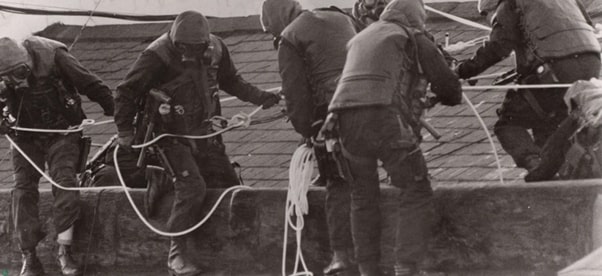 Fig.6 SAS Red Team prepare for their descent on the Embassy rooftop
Fig.6 SAS Red Team prepare for their descent on the Embassy rooftop
4. Operation Nimrod Begins
The Operation Nimrod assault began with a diversionary explosion from the skylight on the third floor. It coincided with the signal for Red Team to abseil from the roof. Meanwhile Blue Team, working simultaneously, executed entry through the library at the rear of the ground floor.
| Red Team (Team 1): Third and Fourth Floors. | Team 1 from Red Team blew in a glass window in the stairwell leading to the second floor. They entered the building and proceeded upstairs to clear the third and fourth floors. |
| Red Team (Team 2): Second Floor (Rear entry) | Team 2 from Red Team was positioned on the roof. They began their descent on two abseil ropes down the rear of the building onto the second-floor balcony. |
| Blue Team (Team 3) First Floor Front | Team 3 from the Blue Team sought entry through the front of the embassy via the first-floor balcony of an adjacent building. A two-man section placed special frame charges of plastic explosives against the window, while the other man of the section provided cover. With plastic explosives pushed flush against the glass, the armoured glass shattered, and the SAS threw flash-bang stun grenades inside. |
| Blue Team (Team 4) Entry on Ground Floor (Rear Entry); Clearing Ground Floor and Stairs; and cellar (Team 5). | An assault team crossed into the garden, smashed its way through the French doors leading into the library and proceeded to clear the ground floor and cellar. |
4.1 Sequence of Events During Operation Nimrod

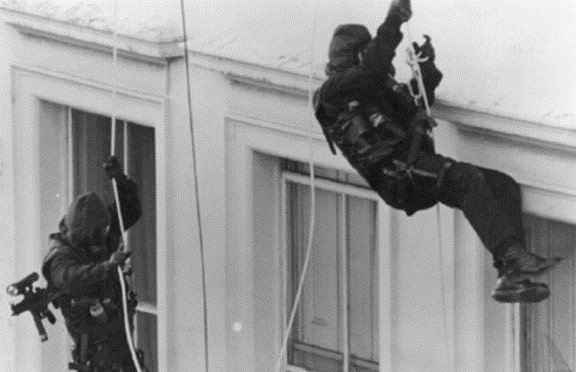 Fig.7 SAS Red Team 2 abseil down to the second-floor of the Embassy.
Fig.7 SAS Red Team 2 abseil down to the second-floor of the Embassy.
5. Conclusion: Lessons from Operation Nimrod
For the SAS, Operation Nimrod justified the years of training and vindicated those who had long defended the need for the regiment’s continued existence. Operation Nimrod’s success did much to counter the negative image actively propagated by the IRA several years prior to the raid.
Further, it also fully justified the establishment of the Special Projects Team. It carried out the assault with a small number of men, roughly 30 to 35 took direct part. By the time of the embassy siege, the SP Team had had seven years in which to prepare for just such an eventuality. A politically fragile situation with potentially adverse consequences was defused in a matter of minutes. Not least, the seven years of careful thought, analysis, rehearsal, and training were shown to have been worthwhile.
5.1 Observations on the Terrorists
The terrorists had been poorly briefed by their handlers. Especially in terms of the irresolution they were likely to encounter on the part of the British government.
The assailants also seemed to have nurtured completely unrealistic expectations of success. They were not highly trained; only their leader, Oan, could communicate in English tolerably well. He used the hostages to translate much of his statements into English. The extent to which the terrorists’ minders in Iraq prepared them for the operation is not known. Although it is regarded as an amateurish affair.
Political problems separate from the military ones facing the SAS as it planned an assault, persisted. Quite apart from the original motives behind the seizure of the American Embassy in Tehran, Iranian officials were persuaded that the siege in London was nothing more than an American-backed plot to pressure Iran into releasing its American hostages, given that American military means had failed to rescue them. Iranian propaganda falsely claimed that the hostages in London were willing to die as martyrs for the Islamic Revolution. If that martyrdom came as a result of an inept British police or military operation, the Iranian government might take action against Westerners.
Yet, the successful outcome of Operation Nimrod also increased overseas demand for information about SAS training techniques.
